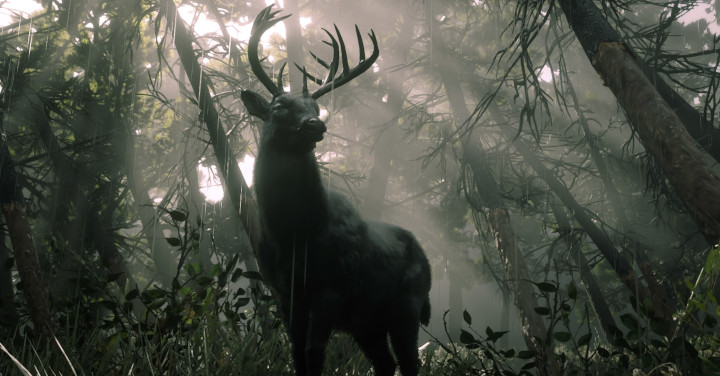
The Compendium was arguably one of Red Dead Redemption 2‘s best features, even though it could ultimately become a source of frustration (anyone who’s tried to hunt the Florida Panther will probably agree with me on the latter part). It creates a permanent record of the animals, outlaws, and weapons you’ve encountered in the game. It was an invaluable asset for those trying to seek every legendary animal and fish.
With the Naturalist Role, Red Dead Online finally added a similar feature, though here it’s called the Field Guide, and it only tracks certain types of animals. Unfortunately, there are no birds or fish in the Field Guide (yet).
In order to acquire the Field Guide, you’ll have to buy into the Naturalist Role, which costs 25 Gold (though it gets a discounted price every now and then). If you need to scrape together the Gold for that, here’s a complete guide to earning Gold in Red Dead Online.
The Field Guide tracks how many times you’ve interacted with various types of animal (for example, how many you killed, sedated, tracked, photographed, etc.) The Field Guide doesn’t start tracking these interactions until you own it, though. Any interactions you’ve had with these critters before acquiring the guide will not be tracked — you’ll start with a clean slate when you first acquire the guide, whether you’re just starting out or have invested hundreds of hours into RDO.
Every animal listing has a completion percentage. This tracks how many of the possible interactions you’ve completed. Since most animals can be killed and skinned or sedated and sampled, you’ll need to encounter most animals at least twice for 100% completion (you can’t sample and skin the same animal). I’ll talk more about specific completion percentage goals in the notes for each section in the Field Guide.
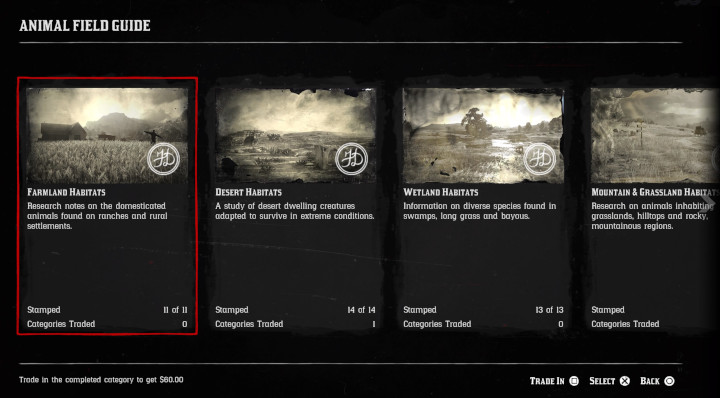
Remember, every time you sell a sample to Harriet, she’ll put a stamp in your Field Guide for that type of animal. If you collect all of the stamps in one group, you can trade them in for a payout in RDO$. This resets the stamp collection, allowing you to do it all over again (though your completion percentages aren’t impacted by stamp selloffs).
If you want to fill the gaps in your own Field Guide, here’s a complete list of every animal, with additional tips to help you find spawn locations.
Farmland Habitats
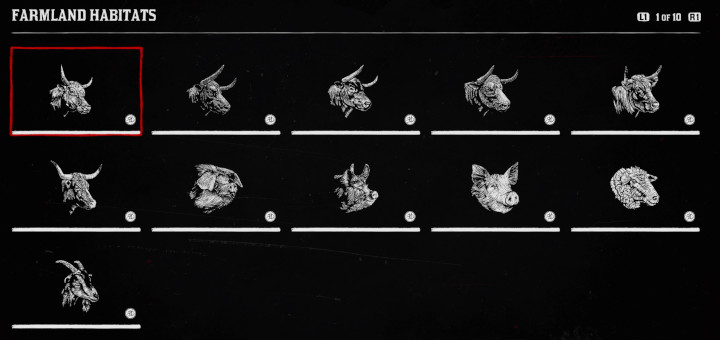
As the title implies, these animals can usually be found on farms. The hardest animals to find in this category are the bulls. For 100% completion, every animal in this category must be:
- Killed
- Skinned
- Studied
- Sedated
- Sampled
- Photographed
Don’t worry about studying, as this will happen naturally as you complete the other interactions.
If you complete the Farmland Habitats stamps, you can trade in the collection for RDO$60.
Florida Cracker Cow
The Florida Cracker Cow can be found on ranches and settlements across the states. As herbivores, their diet consists of grains, hay and grasses. The large size of these mammals can mean that it takes longer to sedate them.
Here’s a video by Dirty Tyler about where to find them (and how to skin them without getting into trouble).
Angus Bull
The Angus Bull can be found on farms and ranches across the states. Its herbivorous diet includes grains, hay and corn. The average size of a bull can mean that they are harder to sedate.
Here’s a Dirty Tyler video that shows the best two locations for bulls:
Note that the types of cows and bulls spawn in at these locations will be random, so you might need to check back a few times before you find the right ones. You can always jump lobbies or simply come back later (I’ve actually seen cows spawn in as I was standing in their pasture).
Devon Bull
The Devon Bull can be found at ranches across the states. As a herbivore, it consumes grains, hay and corn. Its stock build may mean it is harder to sedate.
You can check out the video in the Angus Bull section to see where to find Devon Bulls, as the specific bulls or cows that spawn in will be random (though cows vastly outnumber bulls).
Hereford Bull
The Hereford Bull can be found at ranches across the states. It is a herbivore, living on grains, hay and corn. Due to their size, Hereford Bulls may take more time to sedate.
Again, you can check out the video under the Angus Bull section to see where to find Hereford Bulls.
Angus Ox
Angus Oxen can be found on ranches and farms across West Elizabeth, New Hanover and Lemoyne. As herbivores, their main diet consists of common roughage including grasses, hay, and silage. Like all oxen, it may take several shots to sedate.
Here’s a Dirty Tyler video that shows oxen locations:
Devon Ox
Devon Oxen can be found on ranches across West Elizabeth, New Hanover and Lemoyne. As herbivores, their main diet consists of common roughage including grasses, hay, and silage. Oxen are tough and will require a large number of shots to be sedated.
You can check out the video in the Angus Ox section of this guide for a video on where to find oxen.
Old Spot Pig
Old Spot Pigs can be found on ranches and towns across New Hanover. Their omnivorous diet consists of lizards, mice, eggs, agricultural crops, fungi, and grasses. Although small, their stocky build means they require a few shots before they are sedated.
Here’s a Dirty Tyler video that shows pig locations:
Note that the pigs that show up in each location will be random. Jump into a new lobby and check the locations again if you don’t find all the pigs you need in one go.
Berkshire Pig
Berkshire Pigs can be found on ranches and in towns across New Hanover. As omnivores, their diet consists of mice, eggs, agricultural crops, fungi, roots, and grasses. Pigs need only a few shots before they are sedated.
Check out the video in the Old Spot Pig section to see possible locations.
Big China Pig
Big China Pigs are found on ranches and in towns across New Hanover. Their omnivorous diet includes mice, worms, eggs, grasses, fungi, and roots. To be fully sedated, these pigs require a few shots.
The video in the Old Spot Pig section has locations for all types of pig.
Merino Sheep
The Merino Sheep can be found on ranches and in towns across New Hanover. As herbivores, they feed on pasture plants, grasses, clovers and forbs. A few shots of sedative will ensure the sheep is unconscious.
Here’s a video on sheep locations from YouTuber Finn Pup:
Alpine Goat
Domestic Alpine Goats can be found at ranches and farms across the states. Their herbivorous diet means that they graze on grasses, weeds, herbs and trees. These goats are relatively easy to sedate with just a few shots of sedative needed.
Here’s a video on where to find Alpine Goats in Red Dead Online (by Dirty Tyler):
Desert Habitats
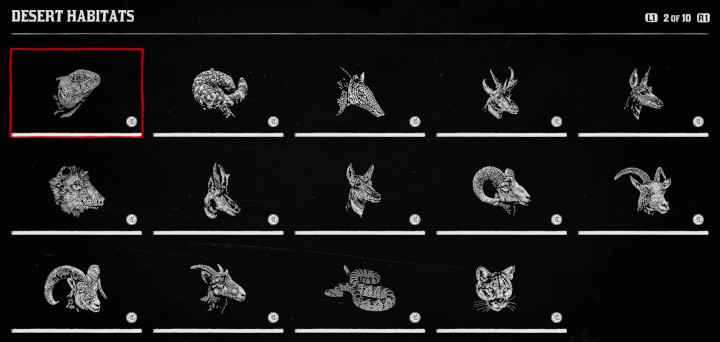
These animals live in the desert, though there are a few in this category (the Sierra Nevada sheep and ram) that can be found up in the mountains north of Strawberry. The hardest one for me to find on this list was the Black Tailed Rattlesnake. The rest are pretty easy (though keeping track of all the various types of pronghorns can be a bit of a pain).
For 100% completion, every animal in this category must be:
- Tracked
- Killed
- Skinned
- Studied
- Sedated
- Sampled
- Photographed
Don’t worry about studying, as this will happen naturally as you complete the other interactions.
If you complete the Desert Habitats stamps, you can trade in the collection for RDO$80.
Desert Iguana
The Desert Iguana is native to New Austin. Generally considered herbivores, eating perennial plants, fruit and occasionally insects, iguanas can be easily sedated.
Here’s an iguana location guide by Dirty Tyler:
Banded Gila Monster
The Banded Gila Monster is native to the deserts of New Austin. As carnivores, they prey on small mammals, lizards, frogs, birds, bird eggs and carrion. Due to their size, they are easily sedated.
Here’s a video by Dirty Tyler that shows Banded Gila Monster locations:
Nine-Banded Armadillo
Nine-Banded Armadillos can be found in the regions of Gaptooth Ridge, Cholla Springs and Rio Bravo. As omnivores, their main diet consists of insects, small vertebrates and often, carrion. Sedative shots can easily pierce their scutes and put them to sleep.
Here’s a Dirty Tyler video that shows where you can find Nine-Banded Armadillos:
Baja California Pronghorn Buck
The Baja California Pronghorn Buck‘s main habitat is Gaptooth Ridge and Rio Bravo. As herbivores, their diet includes sagebrush, green shoots, grasses and forbs. These large mammals require multiple doses of sedative.
All of the pronghorn in the Desert Habitats category can be found in great numbers pretty much everywhere in New Austin. They’re not hard to find.
Baja California Pronghorn Doe
The Baja California Pronghorn Doe‘s main habitat is Gaptooth Ridge and Rio Bravo. As herbivores, their diet includes sagebrush, green shoots, grasses and forbs. These large mammals require more sedative before they are rendered unconscious.
All of the pronghorn in the Desert Habitats category can be found in great numbers pretty much everywhere in New Austin. They’re not hard to find.
Collared Peccary
The Collared Peccary is native to New Austin. Their herbivorous diet consists of agave, prickly pear cacti, mesquite beans, fruits, nuts, and roots. Due to its tough hide, the Collared Peccary may take a few shots before it is sedated.
Here’s a Dirty Tyler video that shows locations for the Collared Peccary:
Sonoran Pronghorn Buck
The Sonoran Pronghorn Buck can be found in the open deserts of New Austin. Their herbivorous diet consists of grasses, forbs, green shoots, and sagebrush. These large mammals require more sedative.
All of the pronghorn in the Desert Habitats category can be found in great numbers pretty much everywhere in New Austin.
Sonoran Pronghorn Doe
The Sonoran Pronghorn Doe can be found in the open deserts of New Austin. Their herbivorous diet consists of grasses, forbs, green shoots, and sagebrush. These large mammals require more sedative.
All of the pronghorn in the Desert Habitats category can be found in great numbers pretty much everywhere in New Austin.
Desert Bighorn Ram
The Desert Bighorn Ram inhabits New Austin. Their herbivorous diet consists of desert holly, cacti, and grasses. To take down a ram of this size, several shots of sedative are needed.
Here’s a guide to finding rams in Red Dead Online by Dirty Tyler:
Keep in mind that the Desert Bighorn Ram will be found in New Austin, while the Sierra Nevada Bighorn Ram will be found in the mountainous regions of other states.
Desert Bighorn Sheep
The Desert Bighorn Sheep inhabits the varied terrain of New Austin. It has a herbivorous diet of desert holly, cacti, and grasses. Only a few shots of sedative are needed for this animal.
Here’s a video that shows a specific spawn point for the Desert Bighorn Sheep:
Sierra Nevada Bighorn Ram
The Sierra Nevada Bighorn Ram can be found in New Austin and West Elizabeth. As herbivores, they graze on forbs, woody vegetation, and grasses. To take down a ram of this size, several shots of sedative are needed.
Here’s a video by Finn Pup that shows Sierra Nevada Bighorn Ram and Sheep locations:
Sierra Nevada Bighorn Sheep
The Sierra Nevada Bighorn Sheep inhabits New Austin and West Elizabeth. As a herbivore, it grazes on forbs, woody vegetation and grasses. A few shots of sedative and this sheep will be asleep.
The Finn Pup video I posted in the Sierra Nevada Bighorn Ram section shows locations for this sheep as well.
Black-Tailed Rattlesnake
The Black-tailed Rattlesnake can be found in New Austin. As carnivores, they prey on small animals like mice, rats and lizards. This snake needs very little sedative.
I had a bit of trouble finding this one, but here’s a video that shows one possible spawn location:
Cougar
Cougars are native to the states of New Austin, West Elizabeth and remote forested sections of New Hanover. As carnivores, they prey on deer, elk, moose, and mountain goats. A liberal amount of sedative is needed for such a creature.
Cougars are actually not that difficult to find (in fact, they’ll find you, more often than not). One semi-reliable place to look is directly north of the O in Cholla Springs on your world map.
Here’s a guide that shows 10 Cougar locations:
Wetland Habitats
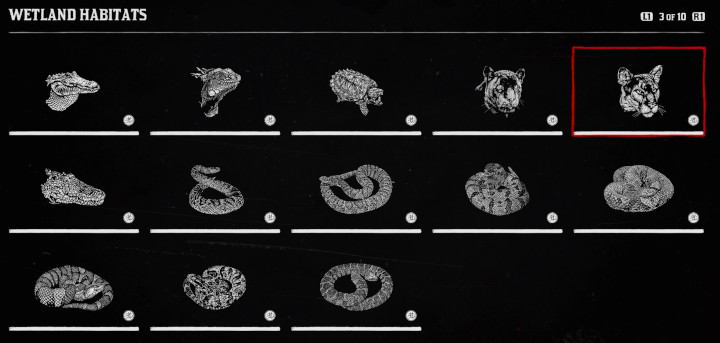
The state of Lemoyne is mostly wetlands, and most of these creatures will be found there. The Florida Panther might be the hardest animal to find in Red Dead Online (and in Red Dead Redemption 2‘s story mode). I find it to be rarer than most of the legendary animals.
For 100% completion, every animal in this category must be:
- Tracked
- Killed
- Skinned
- Studied
- Sedated
- Sampled
- Photographed
Don’t worry about studying, as this will happen naturally as you complete the other interactions.
If you complete the Wetland Habitats stamps, you can trade in the collection for RDO$110.
American Alligator (Small)
Alligators live in the swamp and river delta regions of Lemoyne. They are carnivorous apex predators, feeding on fish, birds, amphibians and mammals. Due to their thick skin, alligators need several shots of sedative before they are unconscious.
In my experience, the smaller alligators seem more likely to spawn in southeast of Rhodes, near Shady Belle.
Green Iguana
Green Iguanas have been known to live on an island in Flat Iron Lake. Primarily herbivores, they feed on plants, leaves, fruit and flowers. Occasionally they will eat eggs, leaf dwelling insects and snails. They are easily sedated.
As the description states, there is one island in Flat Iron Lake where you’ll find iguanas. Check out the marker on this map:
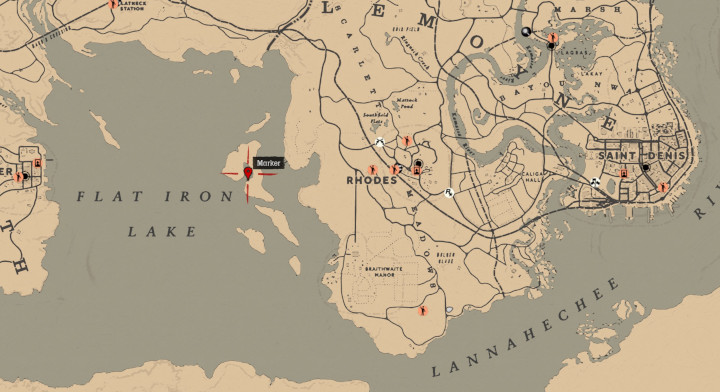
Alligator Snapping Turtle
The Alligator Snapping Turtle is native to the swamplands of Lemoyne. Their primarily carnivorous diet means they prey on other small turtles, frogs, snakes, as well as some aquatic plants. These turtles require very little sedative.
Alligator Snapping Turtles can typically found in the same places you find alligators — pretty much the entire swampy area of Lemoyne, from Bluewater Marsh all the way to Shady Belle.
Panther
Panthers are native to the remote forested wetlands of Lemoyne. As carnivores, they prey on deer, wild boars and goats. These large mammals require multiple shots of sedative to bring them down.
I have two locations where I can consistently find panthers in both Red Dead Online and Red Dead Redemption 2‘s story mode. This one (south of Rhodes) seems to do better during the day:

And this one (across the river from Harriet’s location near Lagras) seems to do better at night:
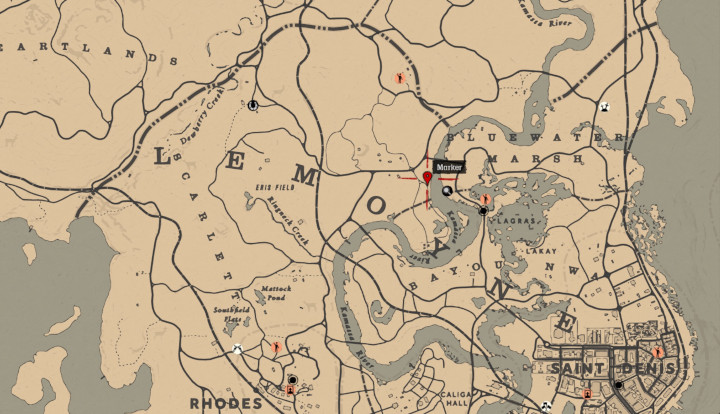
Keep in mind that this might just be RNG. In either of these locations, you might see a Panther, a Florida Panther, or one of the Legendary Panthers.
Florida Panther
The Florida Panther can be found in the remote forested wetlands of Lemoyne. As carnivores, they prey on racoons, white-tailed deer, feral hogs, and occasionally alligators. Strong creatures, they need several shots of sedative to be fully unconscious.
This is probably the rarest creature in Red Dead Redemption 2. Check my maps in the Panther section to see where I tend to find Florida Panthers. Keep in mind that you can find Panthers, Florida Panthers, or Legendary Panthers in these locations, and the one you get is based on luck. And Florida Panthers are super rare. Pray that the RNG gods smile upon you, friend.
American Alligator
Alligators live in the swamp and river delta regions of Lemoyne — in southern Bluewater Marsh and all around Bayou Nwa. They are carnivorous apex predators, feeding on fish, birds, amphibians and mammals. Due to their tough skin, American Alligators will a large amount of sedative.
You really can’t miss alligators. Fast travel to Legras, then head into the swamp. Just don’t get eaten.
Diamondback Rattlesnake
The Diamondback Rattlesnake is native to Lemoyne, New Hanover and parts of West Elizabeth. As carnivores, they prey on ground dwelling birds, mice, rabbits, and gophers. Snakes need very little sedative.
Here’s a video that shows all snake locations in Red Dead Online.
Note that various snakes share spawn locations, so there’s a bit of RNG to finding the particular snake you’re looking for.
The best method for finding snakes is to ride your horse around until it gets frightened and you see a red spot show up on your minimap. That’s almost always a snake. Quickly use Eagle Eye and see if you can track it before it scampers off.
Midland Water Snake
Midland Water Snakes are native to the coastal shores of Roanoke Ridge and swamplands of Lemoyne. Their carnivorous diet consists of game, frogs, salamanders, and fish. The snake is easily sedated.
You can check the snake location video I posted above, but note that water snakes are found gliding on the surface of the water. This makes them tough to sample, because they like to stay out in water that’s slightly too deep for you to properly sample them once they’re sedated. The trick is to fire a warning shot and try to scare the snake closer to shore before you sedate it.
Timber Rattlesnake
The Timber Rattlesnake is native to Lemoyne, New Hanover and parts of West Elizabeth. As carnivores, they prey on small birds, mice, rabbits, and lizards. Like all snakes, only a small amount of sedative is needed.
You can check the snake video above if you need some locations for where you might find the Timber Rattlesnake. In my experience, this one tends to be one of the more common snakes, especially in forested areas.
Northern Copperhead Snake
Northern Copperhead Snakes can be found across New Hanover and Lemoyne. Their carnivorous diet consists of mice, lizards, insects and small birds. Use a small dose of sedative to render this creature unconscious.
Again, check out the video above for snake spawn locations.
Southern Copperhead Snake
Southern Copperhead Snakes can be found across New Hanover, Lemoyne, and southern areas of West Elizabeth. Their carnivorous diet consists of mice, lizards, insects, and small birds. They need very little sedative.
Check out the video above for all snake spawn locations.
Cottonmouth Snake
Cottonmouth Snakes are native to the coastal shores of Roanoke Ridge and swamplands of Lemoyne. Their carnivorous diet consists of game, frogs, salamanders, and fish. If sedating, only a couple of shots are needed.
Note that the Cottonmouth Snake skims on the surface of the water. Check out the Midland Water Snake section for more advice on water-based snakes.
Northern Water Snake
Northern Water Snakes are native to the coastal shores of Roanoke Ridge and swamplands of Lemoyne. Their carnivorous diet consists of game, frogs, salamanders, and fish. Use a small amount of sedative when subduing this water snake.
Check out the Midland Water Snake section for more advice on water-based snakes.
Mountain & Grassland Habitats
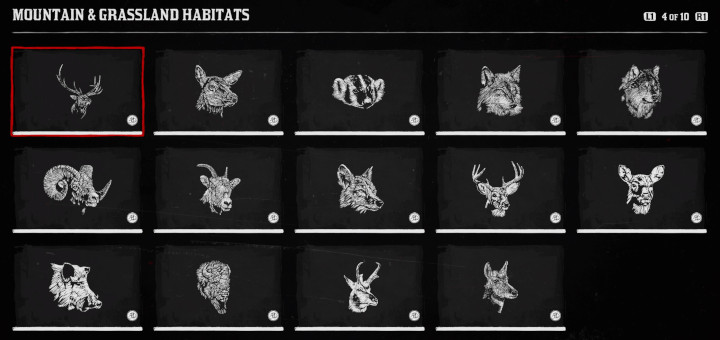
This is a pretty mixed bag of animals that can be found all over the world map. If you’re looking for an easy set to collect, this one might be a good choice. It’s certainly easier than the Wetlands Habitats set.
For 100% completion, every animal in this category must be:
- Tracked
- Killed
- Skinned
- Studied
- Sedated
- Sampled
- Photographed
Don’t worry about studying, as this will happen naturally as you complete the other interactions.
If you complete the Mountain & Grassland Habitats stamps, you can trade in the collection for RDO$140.
Rocky Mountain Bull Elk
The Rocky Mountain Bull Elk is native to Ambarino and northern New Hanover. Their herbivorous diet includes grasses, leaves, bark and plants. Elk are easily startled, so it is advised to keep as much distance as possible whilst tracking. Like other large mammals, a good amount of sedative is needed to render them unconscious.
Elk shouldn’t be too hard to find, but if you need help, here’s a video by Dirty Tyler that shows some spawn locations:
Rocky Mountain Cow Elk
The Rocky Mountain Cow Elk is native to Ambarino and northern New Hanover. Their herbivorous diet includes grasses, leaves, bark and plants. Elk are easily startled, so it is advised to keep as much distance as possible whilst tracking. Several shots of sedative will be needed to take down such a large animal.
You can check out the video above to see where to find Elk in Red Dead Online.
American Badger
The American Badger can be found across the more arid climates of America. It is a fossorial carnivore, preying on squirrels, moles, prairie dogs and voles. Badgers require very little sedative before falling unconscious.
Here’s a video guide by Dirty Tyler that will help you find American Badgers in Red Dead Online:
Gray Wolf
The Gray Wolf‘s main habitat is in the Big Valley region and north Tall Trees. As carnivores, their diet consists of deer and mountain goats, as well as smaller animals like birds, beavers, and fish. A substantial amount of sedative will put a wolf to sleep.
Gray Wolves shouldn’t be hard to find in Red Dead Online. However, if you’re struggling to find some, ride north along the trail marked below at night and you’ll almost certainly be attacked by some. (Little Creek River is just north of Strawberry.)
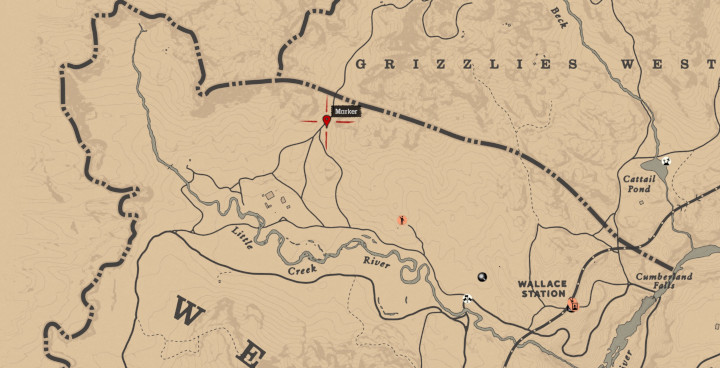
Timber Wolf
The Timber Wolf is native to Cumberland Forest and the Grizzlies. Its carnivorous diet consists of elk, mice, rabbits, and squirrels. Be prepared to administer multiple shots of sedative.
Timber Wolves are a bit rarer than Gray Wolves, but they’re not super difficult to find if you know where to look. Here’s a video by Finn Pup to show you some of the places you might find them:
Rocky Mountain Bighorn Ram
The Rocky Mountain Bighorn Ram‘s main habitat is the Grizzlies region. They are herbivores, mainly consuming grasses and sedges, but they will eat woody plants in the winter. The easiest way to take down a ram of this size is by using a good amount of sedative.
Here’s a great spot for farming Rocky Mountain Bighorn Rams and Rocky Mountain Bighorn Sheep (video by SaoBilious):
Note that this video was made in Red Dead Redemption 2 story mode, but this spot also works in Red Dead Online.
Rocky Mountain Bighorn Sheep
Rocky Mountain Bighorn Sheep are native to the Grizzlies and Cumberland Forest. This herbivore mainly lives on grasses and sedges, as well as woody plants in the winter. Sheep require a reasonable amount of sedative before they can be sampled.
You can use the same location shown in the video above to find Rocky Mountain Bighorn Sheep.
California Valley Coyote
The California Valley Coyote can be found across New Austin, West Elizabeth, Lemoyne, and New Hanover. Their diet is primarily carnivorous, consuming the meat of rodents as their main food source. A few shots of sedative are all a coyote needs.
California Valley Coyote are certainly not rare, and they tend to roam in packs. You’ll find them just about everywhere (aside from the snowy regions), and they bark a lot so they’re not hard to locate just by audio.
Whitetail Buck
The Whitetail Buck can be found in forested areas across the states. It is a herbivore, and consumes nuts, buds, twigs, and green plants. Keeping your distance when hunting deer can increase your chances of administering multiple shots of sedative.
Whitetail Deer can be found pretty much everywhere, though bucks tend to be a bit rarer than their female counterparts.
Whitetail Deer
Whitetail Deer can be found in a variety of habitats across the states, but are common to the forests of New Hanover, Lemoyne, and West Elizabeth. Their herbivorous diet includes grasses, nuts, fungi, twigs, and fruit. Like all deer, several shots of sedative will be needed.
Whitetail Deer are pretty much everywhere. They’re one of the most common animals in Red Dead Online, so you should have no trouble finding them.
Wild Boar
Wild Boars can be found across the states of New Hanover, Lemoyne, and West Elizabeth. They are omnivores, preying on amphibians, reptiles, insects, worms, and smaller mammals. They also eat roots and fruit. Multiple shots of sedative are needed to bring down this animal.
Here’s a video guide (by Dirty Tyler) that will help you find Wild Boars in Red Dead Online:
American Bison
The American Bison is native to the plains of New Hanover and West Elizabeth. As a herbivore, it grazes on grains, hay and corn. Due to the size of an average bison, a large amount of sedative must be administered before a sample can be safely taken.
This Dirty Tyler video shows spawn locations for the American Bison:
American Pronghorn Buck
The American Pronghorn Buck is native to the wide open grasslands of New Hanover and West Elizabeth. As herbivores, their diet includes sagebrush. green shoots, grasses and forbs. Several shots of sedative are needed to take down this buck.
I almost always find American Pronghorn along Little Creek River north of Strawberry. Check the area between the two red markers on this map:
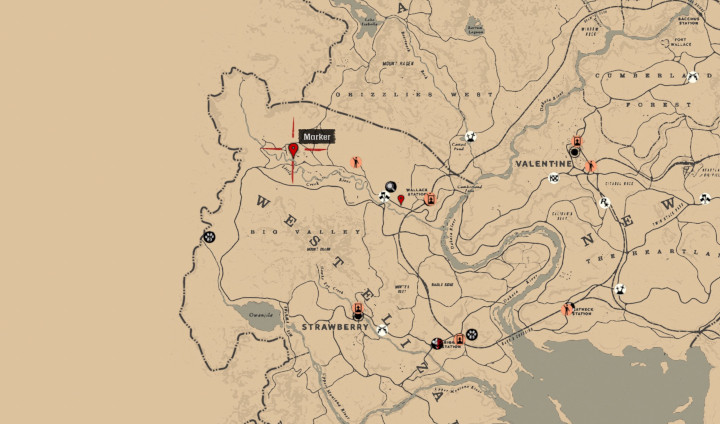
American Pronghorn Doe
The American Pronghorn Doe is native to the wide open grasslands of New Hanover and West Elizabeth. As herbivores, their diet includes sagebrush. green shoots, grasses and forbs. Be ready to administer multiple shots of sedative.
Check out the American Pronghorn Buck section for information on where to find them.
Forest & River Habitats

These animals are typically found in the northern wooded regions of the world, though some of them (such as the Black-Tailed Jackrabbit and Virginia Opossum) can be found all over the map. The hardest animals to find in this set are the moose, which tend to be quite rare.
For 100% completion, every animal in this category must be:
- Tracked
- Killed
- Skinned
- Studied
- Sedated
- Sampled
- Photographed
Don’t worry about studying, as this will happen naturally as you complete the other interactions.
If you complete the Forest & River Habitats stamps, you can trade in the collection for RDO$160.
American Black Bear
The American Black Bear is found in the remote woodlands of Roanoke Ridge, Big Valley and Tall Trees. It is smaller than the Grizzly Bear. The main diet of these omnivorous animals consists of salmon, honey, fruit, small mammals and carrion. Multiple shots of sedative are needed to penetrate its thick fur.
This Dirty Tyler video shows locations for both types of bear in Red Dead Online:
North American Beaver
The North American Beaver can be found along the Kamassa River in Roanoke Ridge. Its herbivorous diet consists of tree bark, cambium, roots, buds, and water plants. Beavers require very little sedative.
Here’s a Dirty Tyler video that should help you find beavers in Red Dead Online:
North American Raccoon
North American Raccoons are found across Lemoyne, New Hanover and West Elizabeth. As omnivores, their diet includes plants, berries, amphibians, rodents, and eggs, depending on their environment. Only a couple of sedative shots are needed.
Racoons aren’t difficult to find, but here’s a Dirty Tyler video in case you need any guidance:
American Red Fox
The American Red Fox is native to the forests and grasslands of West Elizabeth, New Hanover, and Lemoyne. As omnivores, their diet consists of small mammals like squirrels and rabbits, as well as birds, fruits, berries, and grasses. A few shots of sedative will render this fox unconscious.
Foxes are rarer than some of the more common animals, but they spawn in quite a few locations. Here’s a video that shows fox locations:
American Gray Fox
The American Gray Fox is native to the forests and grasslands of West Elizabeth, New Hanover, and Lemoyne. As omnivores, their diet consists of small mammals like squirrels and rabbits, as well as birds, fruits, berries, and grasses. Foxes can be easily sedated with just a few shots.
You can check out fox spawn locations in the video above.
Silver Fox
The Silver Fox can be found in various habitats across the states. They are omnivores, feeding on plant matter, rodents, insects, birds, and carrion. This fox will only need a small number of sedative shots.
You can check out fox spawn locations in the video above.
Striped Skunk
The Striped Skunk can be found in a variety of habitats across the states. Their omnivorous diet consists of insects, fish, crustaceans, small mammals, grasses, fruits, and carrion. Skunks have the ability to create a spray using their scent glands to deter predators. Due to their size, only a small amount of sedative is needed to subdue a skunk.
Skunks are pretty common, but here’s a video that shows where you can find them:
Note that skunks are nocturnal, so you’ll only find them at night.
Virginia Opossum
The Virginia Opossum can be found in a variety of habitats across the states. As omnivores, their diet consists of grains, nuts, fruits, amphibians, birds and their eggs, mice, and carrion. Very little sedative is needed.
Opossoms aren’t hard to find, though they are rarer than skunks. They are also nocturnal like skunks. Here is a video that shows spawn locations:
American Muskrat
The American Muskrat‘s main habitat is along the rivers and shores of New Austin, West Elizabeth, Lemoyne and New Hanover. As omnivores, their diet consists of aquatic vegetation, small fish and amphibians. This rodent needs a small dose of sedative.
To find a muskrat, walk along the banks of any river in the game. Here’s a video that shows exact spawn locations:
And be careful. They bite!
Western Bull Moose
The Western Bull Moose is native to the state of West Elizabeth. Their omnivorous diet includes shoots from willow and birch trees, aquatic plants and forbs. These large mammals require several shots of sedative before they can be safely sampled.
Here’s a Dirty Tyler guide to finding Western Moose in Red Dead Online:
Western Moose
The Western Moose can be found in the remote forested areas of West Elizabeth, Ambarino and New Hanover. Their omnivorous diet includes shoots from willow and birch trees, aquatic plants and forbs. Use a large dose of sedative to bring down this mammal.
See the guide in the previous section for information on where to find the Western Moose.
Grizzly Bear
Grizzly Bears are endemic to Grizzlies East. As an omnivore, its diet ranges from berries roots, and grasses to deer, elk, fish, and carrion. Be warned, a large amount of sedative is needed to safely subdue a Grizzly Bear.
You can check out the video in the American Black Bear section to see where to find Grizzly Bears.
Black-Tailed Jackrabbit
The Black-Tailed Jackrabbit can be found in a variety of habitats across the states. As herbivores, their diet consists of vegetation forbs, buds, twigs, bark, and crops, which is why they are considered pests. Only use a couple of sedative shots on these creatures.
Black-Tailed Jackrabbits are one of the most common animals in Red Dead Redemption 2. As long as the snow isn’t too deep, you can find them just about everywhere.
Common Critters
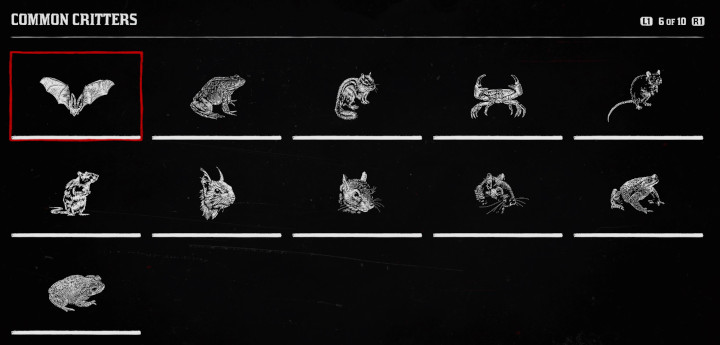
These animals are very small, and typically require a small game arrow to kill them without damaging the carcass. Because they’re too small, you cannot sedate them with the varmint rifle.
For 100% completion, every animal in this category must be:
- Tracked
- Killed
- Collected
- Studied
- Photographed
The one exception is the Little Brown Bat, which cannot be tracked (since it’s a flying creature). Don’t worry about studying, as this will happen naturally as you complete the other interactions.
Because you can’t sedate and sample these animals, you cannot collect stamps for them, therefore there is no sale price for a complete collection.
Little Brown Bat
The Little Brown Bat is found across most of America. They are insectivores, feeding on mosquitos, wasps, beetles, and midges. Due to the size of this species of bat, they can be killed with less impact. Attempting to sedate this creature will result in its death.
These little critters are very common, but they only come out at night. They’re particularly plentiful in Lemoyne, and they make a distinctive squeaking sound when they are close to you.
Here’s a video by Finn Pup that shows some easy farming locations:
American Bullfrog
The American Bullfrog is often found near calm and shallow waters in warmer climates like Bayou Nwa and Bluewater Marsh. As carnivores, they prey on small fish and insects. They are cannibalistic and will eat their own kind. The size of this species of frog means that even the smallest dose of sedative will be fatal.
As the description states, the American Bullfrog can be found near the water’s edge mostly in Lemoyne. I also spot them near the San Luis river in New Austin.
Here’s a video in case you need any help:
Western Chipmunk
Western Chipmunks are native to forested and brush heavy areas of New Hanover, Lemoyne and West Elizabeth. As omnivores, they forage for seeds, buds, fruits, and nuts. Chipmunks are too small to be sedated successfully.
Here’s a Dirty Tyler video to help you find some Western Chipmunks in Red Dead Online:
And I’ve found that this area right here is ideal for farming Western Chipmunks:
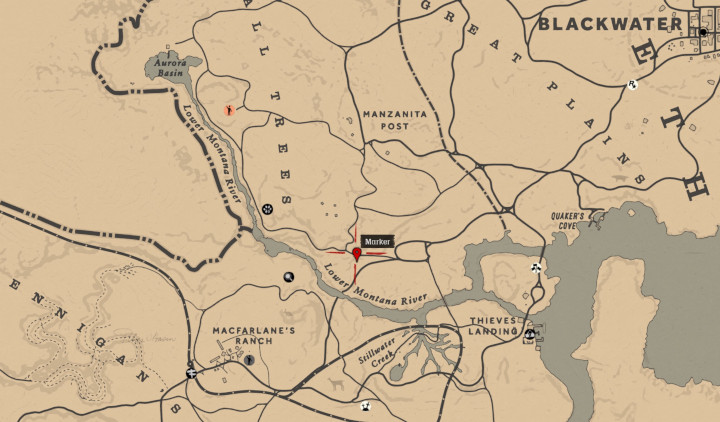
Cuban Land Crab
The Cuban Land Crab is native to an island on Flat Iron Lake. As omnivores, their diet consists of leaves, grasses, insects and carrion. Attempting to sedate a crab will result in its death.
There’s only one place in Red Dead Online where you can find Cuban Land Crabs: The same island where you’ll find the Green Iguana.

Black Rat
Black Rats can be found in Saint Denis and other highly populated areas. As omnivores, they scavenge for any scraps they can find, including seeds, leaves, agricultural crops and fungi. Sedative is too strong to be used on such a small creature. A single shot will kill it.
The best spot I’ve found for farming rats is inside an abandoned fort southwest of Van Horn. Here’s where you can find it on the map:
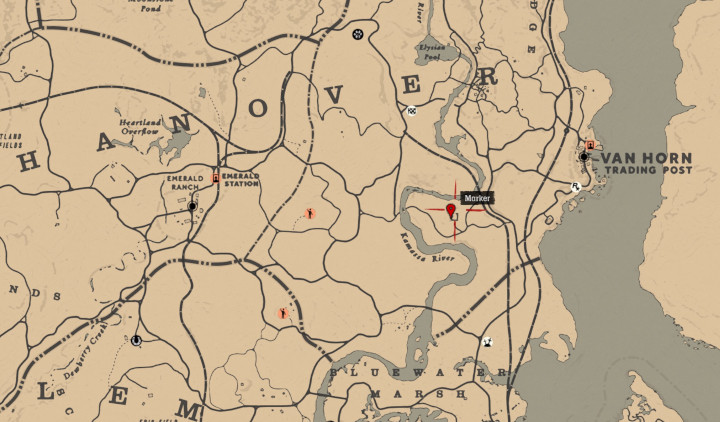
Brown Rat
Brown Rats can be found in Armadillo and other densely populated areas. Their omnivorous diet is based on scavenging food, as well as grains, seeds, small mammals, and birds. Any amount of sedative will prove fatal.
Like the Black Rats, Brown Rats can be found in a fort southwest of Van Horn. Check out the image above to see the exact location.
American Red Squirrel
American Red Squirrels are native to forested regions of West Elizabeth and New Hanover. As omnivores, their diet consists of small animals such as mice as well as nuts, seeds and mushrooms. Do not attempt to sedate this animal. The dosage is too strong.
Squirrels can be found pretty much everywhere, but you’ll have the most luck in the northern, forested regions. Here’s a Dirty Tyler video that shows spawn locations:
Western Gray Squirrel
The Western Gray Squirrel is native to the forested regions of West Elizabeth and New Hanover. Its omnivorous diet consists of nuts, berries, seeds, eggs, and small birds. Squirrels are too weak to be sedated successfully.
Check out the video in the previous section to see squirrel spawn locations.
Black Squirrel
The Black Squirrel is native to the woodlands of New Hanover and parts of West Elizabeth. Its omnivorous diet consists of seeds, nuts, small insects and fungi. Attempting to sedate a squirrel will result in its death.
Again, check out the video in the American Red Squirrel section to see squirrel locations.
Western Toad
Western Toads are native to the Lemoyne wetlands. As carnivores, they prey on large bees, beetles, ants, crayfish, and arachnids. Toads will die if given any amount of sedative.
Here’s a Dirty Tyler video with Western Toad locations:
Sonoran Desert Toad
Sonoran Desert Toads are native to Rio Bravo. As carnivores, they prey on centipedes, lizards, spiders, and mice. Note that a sedative shot is too powerful to be used on such a small creature.
Sonoran Desert Toads are somewhat rare, though I occasionally see them on the southern shore of New Austin. Try the area marked on this map:
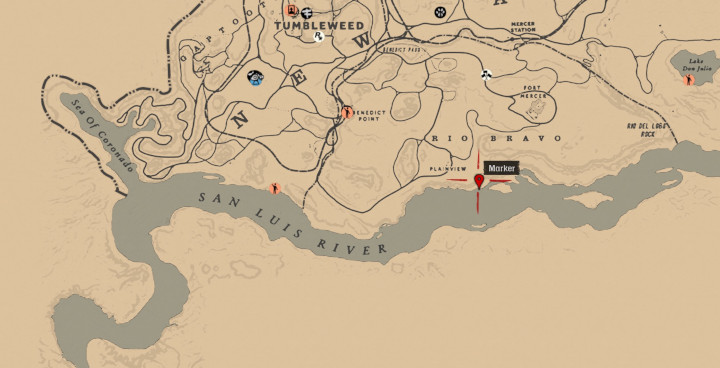
Legendary Animals: Dark
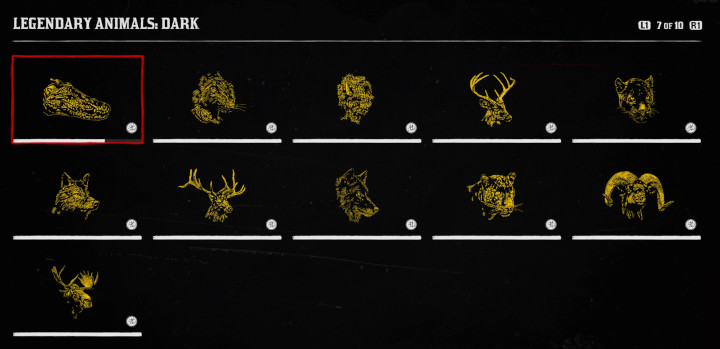
Now we’re getting into the Legendary Animals, which are broken into four categories based on coloration. The first section is the dark animals.
For 100% completion, every animal in this category must be:
- Tracked
- Killed
- Skinned
- Studied
- Sedated
- Sampled
- Photographed
Don’t worry about studying, as this will happen naturally as you complete the other interactions.
If you complete the Legendary Animals: Dark stamps, you can trade in the collection for RDO$680.
Legendary Teca Gator
This alligator is rumored to reside in the Lannahechee River, southwest of Saint Denis. It is famous for its slick black skin, a prized trophy for any poacher. If approaching, be wary of its powerful jaws which can deliver a deadly bite. This species is most active at night, when it is well camouflaged in the dark water. It can often be spotted during heavy storms.
Look for the Legendary Teca Gator on the shore between Saint Denis and Shady Belle. It appears in stormy or foggy weather between 9 p.m. and 6 a.m.
Here’s a video by GTA Series Videos for more information:
Legendary Night Beaver
The elusive Legendary Night Beaver has been spotted in Roanoke Ridge. Its soft black coat is incredibly rare. A strong swimmer, this beaver feels safest in the water, and will seek cover if intimidated. Annesburg has seen an influx of poachers, coming to the area with plans to track the animal. With this in mind, Naturalists should prepare for competition.
This is a Legendary Animal Sighting mission available from Harriet after reaching Naturalist Rank 5.
Here’s a video with some more information:
Legendary Tatanka Bison
This subspecies of bison has been spotted grazing near Heartland Overflow. It can be distinguished from common black bison by the white coloring across its head and back. Large and muscular, these creatures will charge if provoked. They are most commonly spotted during the day, in rain and drizzly weather.
The Legendary Tatanka Bison can be found in heartland Overflow. It is more common to find it between 9 a.m. and 6 p.m. in rainy weather.
Here’s a video with more information:
Legendary Shadow Buck
Stories concerning this unusual buck have been spread through Annesburg. It is said to have an entirely black coat and a dark set of antlers. Like all deer, this buck can be skittish and will flee if disturbed. It has also been known to charge. The popularity of these rumors has alerted poachers to its existence. If tracking, keep your distance and approach with considerable care.
The Legendary Shadow Buck can only be accessed via a Legendary Animal Sighting mission available from Harriet after reaching Naturalist Rank 5.
Here’s a video with some more information:
Legendary Sapa Cougar
A rare cougar is rumored to stalk through the northeast of New Austin. It is famous for its fully black coat. Known to kill livestock, this cougar has a fierce reputation among the locals who are afraid to cross its path. As a rare specimen, it has become a prime target for poachers who have been spotted in the area. Stay alert. If this cougar attacks, it could be fatal.
The Legendary Sapa Cougar can only be accessed via a Legendary Animal Sighting mission available from Harriet after reaching Naturalist Rank 5.
Here’s a video with some more information:
Legendary Midnight Paw Coyote
Hunting southeast of Strawberry, this coyote is well-known to the local people, even if few have seen it firsthand. With unique yellow eyes and black fur, it is easily distinguished from the more common coyotes in the area. Highly cautious, coyotes will flee from nearby humans. They are active from dawn, hunting late into the day. They prefer dry weather over rain.
Look for the Legendary Midnight Paw Coyote southeast of Strawberry between 6 a.m. and 9 p.m. when the weather is clear.
Here’s a video with more information.
Legendary Katata Elk
This elk is local to Cumberland Forest, where travelers have reported seeing glimpses of its distinctive black coat and antlers. Large and powerful creatures, elks are known to be territorial and to charge if threatened. Keeping your distance is recommended. This elk has been spotted during the day.
Look for the Legendary Katata Elk in Cumberland Forest between 8 a.m. and 6 p.m. It can also spawn at night in foggy weather.
Here’s a video with more information:
Legendary Onyx Wolf
The Legendary Onyx Wolf has been spotted passing by Wapiti. It is famous for its bright yellow eyes which stand out against its dark fur. Guarded and territorial, it will attack if humans get too close. This wolf is most active at night.
Look for the Legendary Onyx Wolf near Wapiti between 9 p.m. and 6 a.m., or during the day if the weather is clear.
Here’s a video with more information:
Legendary Nightwalker Panther
Travelers have sighted this panther southwest of Bolger Glade. Although covered mostly in black fur, this panther sports noticeable spots. Well hidden in the undergrowth, these creatures are dangerous to track. They hunt at dusk, during the hours of low light, and are at home in fog and mist.
Look for the Legendary Nightwalker Panther south of Braithwaite Manor between 5 p.m. and 5 a.m. when it’s foggy out.
Here’s a video with more information:
Legendary Rutile Horn Ram
This rare ram has been sighted in Rio Bravo and in Cholla Springs. Its wool is black and its horns dark red. It is known to charge at passersby and attack other animals in its territory. Word has spread fast, due to the aggressive nature of the ram. Those studying it should keep a safe distance to avoid being charged.
The Legendary Rutile Horn Ram can only be accessed via a Legendary Animal Sighting mission available from Harriet after reaching Naturalist Rank 5.
Here’s a video with more information:
Legendary Knight Moose
This moose has been seen in the north of Roanoke Ridge, grazing around the Kamassa River. It is known for its unique dark coat. Moose are shy creatures and will run if startled, so approach quietly and carefully. They are most active during the day, their thick fur allowing them to endure any weather.
Look for the Legendary Knight Moose north of Annesburg near Brandywine Drop around 8 a.m. and 8 p.m.
Here’s a video with more information:
Legendary Animals: Light
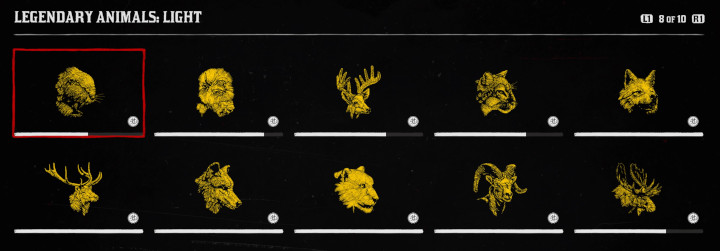
And now we move on to the lighter color Legendary Animals.
For 100% completion, every animal in this category must be:
- Tracked
- Killed
- Skinned
- Studied
- Sedated
- Sampled
- Photographed
Don’t worry about studying, as this will happen naturally as you complete the other interactions.
If you complete the Legendary Animals: Light stamps, you can trade in the collection for RDO$500.
Legendary Moon Beaver
This beaver can be found near the Kamassa River where they build their dams. With its white fur and black tail, it is of great interest to poachers and trappers. Cautious of humans, beavers will flee if approached. They may also bite and nip. This particular species is most active at the start and end of the day.
Look for the Legendary Moon Beaver west of Van Horn between 6 a.m. and 9 a.m. or between 5 p.m. and 9 p.m. It prefers rainy weather.
Here’s a video with more information:
Legendary Winyan Bison
This bison is said to make its home just west of Deadboot Creek. Its dense, pale yellow fur helps to camouflage it against the Ambarino snow. Bison can be unpredictable creatures. Maintaining a safe distance is recommended. This bison is most active in the dark, on dry, clear nights.
Look for the Legendary Winyan Bison around Lake Isabella on clear nights between 9 p.m. and 6 a.m.
Here’s a video with more information:
Legendary Snow Buck
Grazing near Aurora Basin, this buck has gained a reputation for its bright white coat. Vigilant and fleetfooted, these bucks will flee if they are aware of a human nearby. Bide your time and approach carefully. This buck is most active in the early morning and during dry weather.
Look for the Legendary Snow Buck in Tall Trees near Aurora Basin between the hours of 5 a.m. and 10 a.m. Your chances of spotting it are higher during clear weather.
Check out this video for more information:
Legendary Iguga Cougar
This cougar has been spotted to the southeast of the Great Plains where it blends into its surroundings, sporting light brown fur with a white neck and stomach. The cougar has been known to attack humans roaming the area. It tends to appear in low light, at the end of the day, and has been sighted during stormy weather.
Look for the Legendary Iguga Cougar in the Great Plans near Quaker’s Cove. Your best chances of finding this cougar are between 5 p.m. and 9 p.m. in stormy weather.
Check out this video for more information:
Legendary Milk Coyote
Residents of Blackwater are concerned about a coyote that has been picking off livestock. Its white fur and pale eyes are instantly recognizable. With a den nearby, it has learned to cross both the countryside and urban area with ease. Locals have threatened to take on the coyote themselves, if it continues to terrorize them. Sociable creatures, prepare to meet others in its pack.
The Legendary Milk Coyote can only be accessed via a Legendary Animal Sighting mission available from Harriet after reaching Naturalist Rank 5.
Learn more by checking out this video:
Legendary Inahme Elk
This unusual elk has been sighted near Spider Gorge. It has thick white fur and dark red antlers with which it has charged at humans, according to various accounts. There has been a recent increase in the number of poachers in the area. Those with intentions to study the animal are reminded to dress warmly to avoid being harmed by the harsh weather.
The Legendary Inahme Elk can only be accessed via a Legendary Animal Sighting mission available from Harriet after reaching Naturalist Rank 5.
You can learn more by checking out the video below.
Legendary Moonstone Wolf
A wolf pack has gained notoriety just north of Cumberland Forest, It has a distinctive leader; a huge white wolf. The pack is known to attack travelers on the roads nearby, attracting the attention of Naturalists and poachers. The Legendary Moonstone Wolf has a loyal following. If tracking, be prepared to encounter the pack.
The Legendary Moonstone Wolf can only be accessed via a Legendary Animal Sighting mission available from Harriet after reaching Naturalist Rank 5.
You can learn more by watching the video below.
Legendary Ghost Panther
Rumor has it that this albino panther prowls around Merkins Waller and Macomb’s End. With fur that is bright white, it stands out in its swampy surroundings. This panther is extremely dangerous and will attack anyone who wanders into its territory, provoked or otherwise. It has been spotted at night and prefers to hunt in wet weather.
The Legendary Ghost Panther can be found between 8 p.m and 8 a.m. near Bluewater Marsh, and you’re more likely to find it when it’s raining.
You can learn more by checking out the video below.
Legendary Gabbro Horn Ram
This ram has been seen traversing the arid terrain of Rio Bravo. It is known for its white skin and prominent black horns. Fast and agile, it can be hard to catch when moving at full speed so approach with care. It is most active from dawn, into the hottest part of the day, and prefers dry weather.
The Legendary Gabbro Horn Ram can be found near Rio Bravo (check south of Fort Mercer) in New Austin between 5 a.m. and 5 p.m. when the weather is clear.
You can learn more about this ram by checking out the video below.
Legendary Snowflake Moose
This moose has been sighted near Barrow Lagoon. With its white coloring, it blends naturally into the snowy landscape. However, its large black antlers are easier to spot. It is a solitary creature and will flee if approached. Sightings have been reported at night, with the animal preferring wet weather.
The Legendary Snowflake Moose can be found near Barrow Lagoon around 8 a.m. or 8 p.m.
You can learn more by checking out the video below.
Legendary Animals: Red & Blond
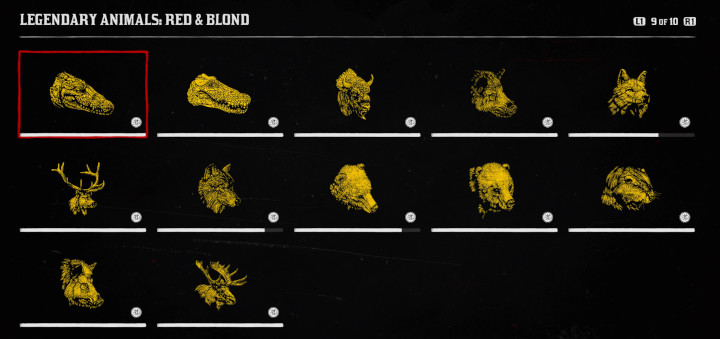
Compared to the light and dark categories, this is a n oddly specific category of Legendary Animals.
For 100% completion, every animal in this category must be:
- Tracked
- Killed
- Skinned
- Studied
- Sedated
- Sampled
- Photographed
Don’t worry about studying, as this will happen naturally as you complete the other interactions.
If you complete the Legendary Animals: Red & Blond stamps, you can trade in the collection for RDO$700.
Legendary Sun Gator
This alligator has been spotted by residents in Lakay. It has a distinctive orange coloring which can be easy to spot among the green and brown of the bayou. It is patient and cunning, biding its time before it takes down prey. It is rarely seen outside the early hours of the morning and favors heavy fog and mist.
The Legendary Sun Gator can be found in the swampland north of Lakay (right on top of the map text that says “Lagras”) or on the riverbank to the east of that location. You’re best chance to spot it is between 6 a.m. and 9 a.m. when the weather is foggy.
You can learn more by checking out the video below.
Legendary Banded Gator
Word has spread about a strange alligator near Saint Denis. It is said to have white skin and a red striped back. With a nest so close to the city, the Legendary Banded Gator is likely to become defensive and territorial. Poachers have been spotted in the area, undeterred by warnings. Do not be fooled by its size. This gator can move with considerable speed.
The Legendary Banded Gator can only be accessed via a Legendary Animal Sighting mission available from Harriet after reaching Naturalist Rank 5.
You can learn more about this creature by checking out the video below.
Legendary Payta Bison
The rare Legendary Payta Bison has been spotted leading a herd in Little Creek. It is easily recognized by its thick red coat. This bison is sociable and can often be found with other bison nearby. Both Naturalists and poachers have a keen interest in such a rare creature. Approach with caution. Herds of bison have been known to trample travelers in these parts.
The Legendary Payta Bison can only be accessed via a Legendary Animal Sighting mission available from Harriet after reaching Naturalist Rank 5.
To learn more about it, check out the video below.
Legendary Wakpa Boar
Travelers have spotted this boar around Stillwater Creek. It sports a dark, rusty coat and has a distinctive white face. If approaching, stay hidden and be prepared. Boars have a tendency to charge. While active during the day, this species will retreat after dark. It relishes rainy weather.
Look for the Legendary Wakpa Boar around Thieves Landing between 9 a.m. and 9 p.m. when it’s raining.
To learn more, check out the video below.
Legendary Red Streak Coyote
Spotted around Pike’s Basin, this coyote is known for stalking the rocky cliffs and barren floor of the canyon. Its red fur helps it stay hidden in arid landscape. Distrusting of strangers, it will give chase if you get too close. It will only appear out in the open during the day and into the evening. A tough creature, it can endure any weather.
Look for the Legendary Red Streak Coyote in the canyons to the west of MacFarlane’s Ranch between 8 a.m. and 10 p.m.
To learn more about this Legendary Animal, check out the video below.
Legendary Ozula Elk
Sightings of this rare elk have spanned the length of Cholla Springs. Its red pelt contrasts its black antlers, setting it apart from more common species. Although known to charge, elks can become distressed when approached and are likely to flee. This subspecies is known to appear at the end of the day and into the night, usually under the cover of mist and fog.
You can find the Legendary Ozula Elk in the Cholla Springs area between 6 p.m. and 6 a.m. in foggy weather.
To learn more about this elk, check out the video below.
Legendary Emerald Wolf
This wolf is frequently sighted around O’Creagh’s Run. It is known for its rusty brown fur and striking green eyes. It stealthy and highly intelligent, unafraid to attack if it feels threatened by other animals or travelers. It is a nocturnal creature that will continue to hunt even in the worst weather conditions.
The Legendary Emerald Wolf can be found in the area around O’Creagh’s Run between 8 a.m. and 8 p.m.
To learn more about this Legendary wolf, check out the video below.
Legendary Ridgeback Spirit Bear
The Legendary Ridgeback Spirit Bear is occasionally seen near Little Creek River. The distinctive red stripe down its back makes it easily recognizable. These bears are extremely aggressive. If you must approach, do so with caution. They are active during daylight hours and retreat at night, preferring bright, clear weather for hunting.
The Legendary Ridgeback Spirit Bear can be found in Big Valley around Little Creek River. Your best chance at spotting it is between 8 a.m. and 8 p.m. when the weather is clear.
You can learn more about this bear by watching the video below.
Legendary Golden Spirit Bear
The Legendary Golden Spirit Bear has been seen in Big Valley. It is known for its blond coat, thick and warm. This bear has gained a reputation, mauling travelers who come too close to its territory. It has attracted the attention of Naturalists who wish to further understand the species, and poachers who prize its luxurious coat. Both are being warned that an encounter could prove fatal.
This bear can only be accessed via a Legendary Animal Sighting mission available from Harriet after reaching Naturalist Rank 5.
You can learn more about it by checking out the video below.
Legendary Zizi Beaver
This beaver has been known to make its home around Owanjila. It is known for its soft blond fur. Beavers are timid so approach quietly. Be warned, they have been known to bite if agitated. This species prefers the low light of dusk and dawn and is unperturbed by weather.
The Legendary Zizi Beaver can be found near Owanjila Dam between 6 a.m. and 9 a.m., or between 5 p.m. and 9 p.m.
You can learn more by checking out the video below.
Legendary Cogi Boar
This uncommon boar is found just north of Bluewater Marsh. It can be quickly identified by its pale bristles. Keep in mind, boars can become aggressive and charge if threatened. This subspecies can be found foraging at dawn.
Look for the Legendary Cogi Boar in the northern part of Bluewater Marsh between 6 a.m and 9 a.m. when the weather is clear.
To learn more, check out the video below.
Legendary Ruddy Moose
The Legendary Ruddy Moose has been sighted in Tall Trees. It has a unique cream hide and a pair of broad red antlers. This moose is solitary and famously elusive. Poachers have been camping in the forest in an attempt to track this animal. If you are lucky enough to spot the moose in the wild, keep your distance or be prepared for a chase.
This moose can only be accessed via a Legendary Animal Sighting mission available from Harriet after reaching Naturalist Rank 5.
To learn more about this Legendary animal, check out the video below.
Legendary Animals: Patterned
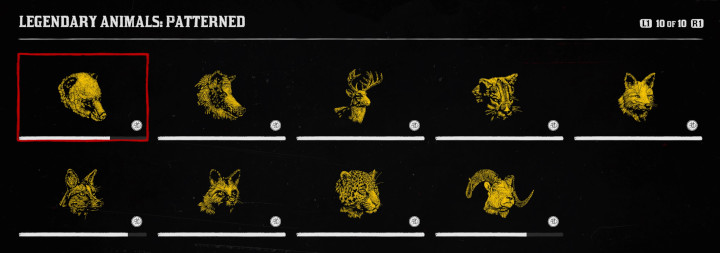
This category of Legendary Animals is just sort of a miscellany of patterned animals that don’t fit into any of the other categories.
For 100% completion, every animal in this category must be:
- Tracked
- Killed
- Skinned
- Studied
- Sedated
- Sampled
- Photographed
Don’t worry about studying, as this will happen naturally as you complete the other interactions.
If you complete the Legendary Animals: Patterned stamps, you can trade in the collection for RDO$480.
Legendary Owiza Bear
This bear has been seen wandering near the Dakota River. It has dark, stocky legs with a gray back and head. A solitary animal, it can be easily aggravated by the presence of humans and will lash out if provoked. It prefers to hunt during the night and, due to its thick fur, can endure heavy rain.
The Legendary Owiza Bear can be found near the Dakota River between Valentine and Wallace Station between 8 a.m. and 8 p.m.
Check out the video below for more information.
Legendary Icahi Boar
The Legendary Icahi Boar has been seen with a herd residing in the east of New Austin. It can be distinguished by its piebald coat of black and white. It is known to become aggressive and territorial in season. Not only are poachers after its unusual coat, its meat is a delicacy too. Approach slowly and quietly or you risk startling it, causing it to run or, worse, attack.
This boar can only be accessed via a Legendary Animal Sighting mission available from Harriet after reaching Naturalist Rank 5.
Check out the video below to learn more about this boar.
Legendary Mud Runner Buck
This unusual buck has been spotted in the south of The Heartlands, by Flat Iron Lake. Its piebald coat sets it apart from the more common bucks living nearby. With their large antlers, these bucks are known to charge at humans if they feel threatened. They are active during daylight hours and prefer dry weather.
Look for the Legendary Mud Runner Buck in the southern portion of the Heartlands between 9 a.m. and 9 p.m. when the weather is clear.
You can learn more about this buck by checking out the video below.
Legendary Maza Cougar
The Legendary Maza Cougar makes its home near the Sea of Coronado. Its distinctive coat of black and white patches is instantly recognizable. Fast and Strong, it is a dangerous predator that prefers the cooler temperatures of dawn alongside calm, clear weather.
This cougar can be found in the southwestern-most portion of New Austin between 6 a.m. and 9 a.m. when the weather is clear.
Learn more about this cougar by checking out the video below.
Legendary Ota Fox
This distinctive subspecies is rumored to have dens in Scarlett Meadows. With a bright white coat and patches of red, it is relatively easy to spot against its green habitat. Like all foxes, it is shy and will run if intimidated. It is most active at the start and end of the day and will not leave its den if the weather is wet.
Look for the Legendary Ota Fox near Ringneck Creek or along the shore of Flat Iron Lake to the northwest of Rhodes. Your best chances of spotting it are between 6 a.m. and 9 a.m. or between 5 p.m. and 9 p.m. in clear weather.
You can learn more by checking out the video below.
Legendary Marble Fox
This fox has been spotted near an abandoned settlement, south of Spider Gorge. It has a unique coat of marbled black and white. It is silent and stealthy and rarely appears in middle of the day or at night, preferring dim daylight. It is often spotted during spells of clear weather.
The Legendary Marble Fox can be found in or around Colter between 6 a.m. and 9 a.m. or 5 p.m. and 9 p.m. when the weather is clear. Try riding the trail between Colter and Cairn Lake to see if you can get it to spawn in.
To learn more about this wily fox, check out the video below.
Legendary Cross Fox
Locals in Bayou Nwa have been telling tales of the Legendary Cross Fox with its distinctive coat, a bright mix of orange, white and gray. It’s known to be sly and nimble and has even been sighted in the city. The legends surrounding it have made it even more valuable to poachers. Naturalist who hope to find it should be in good shape. Be quick with the sedative or prepare for a chase.
The Legendary Cross Fox can only be accessed via a Legendary Animal Sighting mission available from Harriet after reaching Naturalist Rank 5.
You can learn more about this Legendary animal by checking out the video below.
Legendary Iwakta Panther
This panther has territory near Braithwaite Manor. Nearby residents have described its bright spotted coat. It is known for attacking other animals as well as lone laborers. While those on the manor are afraid to wander too far, poachers have taken a keen interest. However, this panther is cunning. It will take a well-trained eye to track its movements.
The Legendary Iwakta Panther can only be accessed via a Legendary Animal Sighting mission available from Harriet after reaching Naturalist Rank 5.
You can learn more about this panther by checking out the video below.
Legendary Chalk Horn Ram
This ram has been spotted high up in the Grizzlies, east of the Calumet Ravine. With a gray body and a bright white head, this ram is of great interest to Naturalists in the area. It has no issue negotiating the rocky landscape and has been seen in both broad daylight and the low light of dusk. However, it is rarely spotted in wet weather.
Look for the Legendary Chalk Horn Ram in the northernmost edge of Ambarino, east of Calumet Ravine. You’ll have a better chance of spotting it between 9 a.m. and 9 p.m. when it’s not raining.
You can learn more about this ram by checking out the video below.
A Few Notes on Legendary Animal Spawn Times and Cooldowns

Before I wrap up this guide, there are a few things to know about Legendary Animal spawns in Red Dead Online that will make hunting them a lot easier.
First off, Legendary Animals can sometimes be found outside of the noted spawn times or weather conditions. What’s noted here are the conditions in which you’re the most likely to find them.
More importantly, Legendary Animals have a 72-hour cooldown. Those are real-world hours, not in-game hours. This means that if you find a Legendary Animal, you won’t be able to find it again for at least 72 real-world hours. This cooldown is activated if you so much as spot the animal — even if you see it and it runs away before you have a chance to sedate or kill it.
The Red Dead Online community seems to believe this cooldown extends to other animals of the same species. So if you spot one Legendary fox, you won’t be able to find any of the other Legendary foxes for at least 72 hours. I have not been able to confirm whether or not this is true for certain.
I want to point out that there’s a way to get around the cooldown timer. If one player in the lobby is not on cooldown and they’re close to a Legendary Animal spawn, this animal can spawn in for anyone who’s in the area. So if you’re playing with a friend who’s not on cooldown, that friend can sometimes successfully spawn the animal for both of you.
And there you go. That’s pretty much everything you’ll ever need to know about completing your Naturalist Field Guide in Red Dead Online.
This is an outstanding guide!
Thanks for the comment! I’m glad you found it to be helpful!